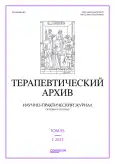Modern content and improvement of high cardiovascular risk strategy in reducing mortality from cardiovascular diseases
- Authors: Boytsov S.A.1,2, Drapkina O.M.3
-
Affiliations:
- National Medical Research Center of Cardiology
- Yevdokimov Moscow State University of Medicine and Dentistry
- National Research Center for Therapy and Preventive Medicine
- Issue: Vol 93, No 1 (2021)
- Pages: 4-6
- Section: Editorial article
- URL: https://journals.rcsi.science/0040-3660/article/view/61612
- DOI: https://doi.org/10.26442/00403660.2021.01.200543
- ID: 61612
Cite item
Full Text
Abstract
The article describes the modern content of the high-risk strategy, which, along with the population strategy, forms the basis of a set of measures to reduce mortality from cardiovascular diseases. The high cardiovascular risk strategy is carried out at the individual level in outpatient structures as a part of primary and secondary prevention of cardiovascular diseases, and is also implemented in hospitals when performing elective surgical procedures, including high-tech interventions. Improving this strategy within the framework of primary health care involves the development of a system of high-risk offices, telemedicine consulting, remote monitoring of physiological parameters on the basis of a regional medical information system, and in the future, on the basis of a uniform vertically integrated medical information system. The development of the high-risk strategy as a part of inpatient practice occurs through the further replication of high technologies and the implementation of new types of them.
Full Text
##article.viewOnOriginalSite##About the authors
Sergey A. Boytsov
National Medical Research Center of Cardiology; Yevdokimov Moscow State University of Medicine and Dentistry
Author for correspondence.
Email: prof-boytsov@mail.ru
ORCID iD: 0000-0001-6998-8406
acad. RAS, Doctor of Medical Sciences, Prof., Gen. dir. NMRCC MH RF, head. department MSMSU after A.I. Evdokimov
Russian Federation, 15a, 3rd Cherepkovskaya street, Moscow, 121552; 20/1, Delegatskaya street, Moscow, 127473Oksana M. Drapkina
National Research Center for Therapy and Preventive Medicine
Email: prof-boytsov@mail.ru
ORCID iD: 0000-0001-6581-4521
Corresponding Member RAS, Doctor of Medical Sciences, Prof., Dir. NMRCTPM
Russian Federation, 10, b.3, Petroverigsky Lane, Moscow, 101990References
- Rose G. Sick individuals and sick populations. Int J Epidemiol. 1985;14:32-8. doi: 10.1093/ije/14.1.32
- Бойцов С.А. Механизмы снижения смертности от ишемической болезни сердца в разных странах мира. Профилактическая медицина. 2013;5:9-19 [Boytsov SA. Mechanisms for reducing mortality from coronary heart disease in different countries of the world. Preventive medicine. 2013;5:9-19 (In Russ.)].
- Невзорова В.А., Плехова Н.Г., Присеко Л.Г., и др. Методы машинного обучения в прогнозировании исходов и рисков сердечно-сосудистых заболеваний у пациентов с артериальной гипертензией (по материалам ЭССЕ-РФ в Приморском крае). Рос. кардиол. журн. [Nevzorova VA, Plekhova NG, Priseko LG, et al. Machine learning methods in predicting the outcomes and risks of cardiovascular diseases in patients with arterial hypertension (based on the materials of ESSE-RF in the Primorsky Territory). Russian Journal of Cardiology (In Russ.)].
- Виноградова Н.Г., Поляков Д.С., Фомин И.В. Анализ смертности у пациентов с ХСН после декомпенсации при длительном наблюдении в условиях специализированной медицинской помощи и в реальной клинической практике. Кардиология. 2020; 60(4):91-100 [Vinogradova NG, Polyakov DS, Fomin IV. Analysis of mortality in patients with CHF after decompensation during long-term follow-up in specialized medical care and in real clinical practice. Cardiology. 2020;60(4):91-100 (In Russ)]. doi: 10.18087/cardio.2020.4.n1014
- Шляхто Е.В., Звартау Н.Э., Виллевальде С.В., и др. Система управления сердечно-сосудистыми рисками: предпосылки к созданию, принципы организации, таргетные группы. Рос. кардиол. журн. 2019;24(11):69-82 [Shlyakhto EV, Zvartau NE, Villevalde SV, et al. Cardiovascular risk management system: prerequisites for developing, organization principles, target groups. Russian Journal of Cardiology. 2019;24(11):69-82 (In Russ.)]. doi: 10.15829/1560-4071-2019-11-69-82
Supplementary files







